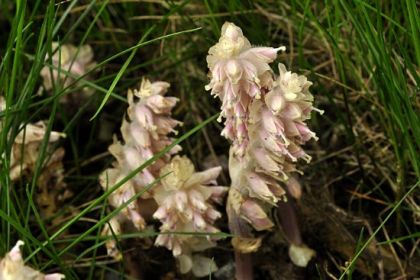In my friends area of East Sussex High Weald ancient woodland, at least five examples of a strange plant have recently appeared. I was at a loss on seeing this broomrape-like plant until back at home this week I managed to track it down. It is Toothwort (Lathraea squamaria). There are only six recorded locations for it in the county, these not including this site, so a good find!
Toothwort is a highly unique plant: all Broomrape family plants steal nutrition from neighbouring plants and also assimilate themselves, but toothwort is the only one that is fully parasitic. The species’ scientific name means ‘hiding’, and indeed most of this completely non-chlorophyllous plant’s life happens out of sight under the ground. Toothwort’s rootstock’s branches have sucking nodules (haustoria) between the branches which attach early in the spring to the host plant’s rootstock. This thankless task is on this occasion performed by hazel or hornbeam? Occasionally lime, ash, maple or alder are used. Scaly leaves next to the ground help toothwort dissipate water, which improves the plant’s ability to suck nutrition from the host plant.

